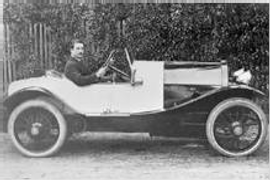BUGATTI Type 18 Models/Series Timeline, Specifications & Photos
First production year: 1912
Engines: Gasoline
Body style: Convertible (spider/spyder, cabrio/cabriolet, drop/open/soft top)
The Type 12 was the most important car built by the French manufacturer before World War One, and out of seven vehicles made, only three survived and entered into the third millennium.
After working for several other automakers, such as Deutz, Isotta Fraschini, and Fiat, Ettore Bugatti started to grow and develop his company. After he developed the Type 13, customers began to ask about the small French car manufacturer from Molsheim, and the young entrepreneur didn’t want to keep them waiting. As a result, he developed the Type 18, a car that became famous, mainly due to its owners. One of them was the famous French pilot Roland Garros.
The car was an engineering marvel for those times. After Bugatti developed the Type 13, he understood that he should reconsider some of the engineering solutions for its vehicles. He developed a new chassis and introduced the double semi-elliptic leaf springs for the front axle. That solution helped the car handle better on rough roads. At the same time, the rear axle relied on quarter-elliptic leaf springs.
One of the most recognizable features of the car was the horseshoe-shaped radiator carried over from the Bugatti Type 13. Even though that was created for a smaller-displacement engine, it fit the bill for the Type 18. The engine compartment covered almost half of the car’s length. Its curved wheel fenders were shaped like a wave from front to back and created an elegant image for the French roadster, and the ones from the back also covered the sprockets for the transmission chains.
The cockpit offered two leather-covered seats for those who were daring enough to ride in that high-performance car. Fronting the occupants was a wooden-crafted dash panel filled with gauges and dials that showed essential information about the engine status and speed. The most important dial was the tachometer, placed in front of the driver.
One of the most essential parts of the car was the inline-four, five-liter engine. It featured a single overhead camshaft driven by a front-mounted shaft connected to the crankshaft and three valves per cylinder. Bugatti noticed the importance of the multi-valve technology developed for the Type 13 and successfully applied it to the Type 18 as well. As a result, he installed two intake valves and one for the exhaust, so the engine was credited with producing 100 PS (97 hp).
Power was sent to the rear wheels via a four-speed manual gearbox connected to the engine via a multi-plate clutch system. One of the advantages of having an exposed sprocket for the chain-driven transmission was that the final drive could be changed quickly to match the owner’s needs. With a top speed credited to be north of 100 mph (160 kph), the Bugatti Type 18 remained one of the most famous cars produced by the French car manufacturer before the Great War started.
